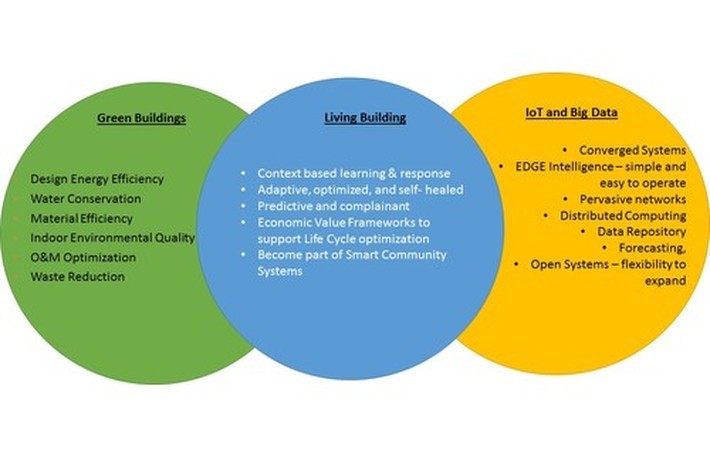
Published on 12/13/2016 | Strategy
According to EPA, “Green Building” is the practice of creating structures and using processes that are environmentally responsible and resource-efficient throughout a building's life-cycle from design, construction, operation and maintenance. Sustainable building design is inherent part of architecture from time immemorial. Historically passive design principles were incorporated to make habitable place in harmony with local conditions. After 1970’s energy crisis these principles became part of standards and compliance. Today, there are many standards and agencies prescribing them with the touch of localization such as IGBC, USGBC, EPA, and Building IQ etc.
Now the question is, with so many standards, best practices, and compliances/norms existing for over 2-3 decades; are we able to achieve our desired outcome? This is a complicated question and answer to this cannot be a direct Yes or No, we need to contextualize problem statement and provide perspective to it. Over years “Green Buildings” initiative has been very successful in most of the areas such as creating awareness, adoption, and influencing market of energy efficient materials and design practices. The focus was around standard and compliance for design, material, site selection to continuous improvement, monitoring, tracking of operations and energy use of building through life-cycle.
Green Buildings design and systems are static though operations and building use need dynamic response to occupant needs, operating policies, change in use of space, etc. Historically, Green Building face challenge due to limited opportunities for integrating different building equipment and systems to get a holistic view of energy and other green factors in order to
Be able to operate building for optimum energy or comfort
Identify failure or degradation signs of equipment
Correlate deviation to change of operations or need
Effective measurement and verification process and tools for energy use, operation and efficiency
Rapid pace of technology development has created a lot of new opportunities for overcoming the challenges faced. Internet of Things (IoT): the generalization in instrumenting buildings with sensors, actuators, micro-chips, micro- and nano-embedded systems and advancements in IT technology and data convergence have found increased relevance in the way Green Buildings are operated transforming them to “Connected Building”.
“Connected Buildings” generate huge data from multiple systems such as energy, IT, Access, Security, operations, etc. Due to variety, velocity, volume of dataconventional methods of manual analysis doesn’t produce desired results, therefore industry categories this as Big Data problem. Big Data is all about seeing and understanding the relationships, patterns within and among pieces of data generated from multiple sources for operational efficiencies, reducing energy consumption, improving occupant experiences, and optimizing financial performance.
IoT combined with ubiquitous computing provided enormous data and information about building.These relationship enable Green building to forecast, predict, and optimize its operations and needs. This ability of Green Building to be self-aware, self-regulated and optimized transforms it into “Sustainable Green Building” also some time termed as “Living Building”.

Below is grid for Green concepts incorporation and pervasiveness of IoT technologies and Big Data analysis on impact or shift/move of “Conventional building” to “Living Building”
IoT and Big Data convergence with Green Buildings is right now in its nascent stage. This convergence is impacting industry and creating a pull by
Evolution and acceptance of wireless networking technologies: “Smart Green Building” will accelerate demand of wireless devices leading to better QoS, low power, and secure devices
Large number of connected devices: Green Building equipment will have IT connectivity over open protocols supported by IT technology for more plug and play devices. This will specifically impact Smart Lighting market, followed by HVAC OEMs for package units, chillers, RTUs, etc.
“Living Buildings” will bring transparency & visibility into operations and building performance. Market for tools such as BIQ from CABA will increase for self-declaration and benchmark against peers, creating crowd sourcing for sustainable environment
Visibility of building operations and advocacy through community portals will create market pull and awareness for better indoor environment and reduction on negative environment impacts
Data gathered from buildings will impact sustainability and design standards to be more empirical in nature. This will provide shift towards economic value framework focusing financial, operational & maintenance metrics to track and predict best design and operational principles
All of these changes are resulting in a significant growth of sustainable market and technology. Wi-Fi connectivity chipset shipments across Bluetooth, Wi-Fi, NFC, GPS, and ZigBee is expected to reach almost 9 billion annual shipments in 2019 as per ABI research. As per Cisco, half of connected devices will account for IoT (4.5 billion in 2015 to 12.2 billion by 2020). Therefore it is clear that IoT and Big Data will act as enablers for transforming green buildings into self-sustained “Living Building”
Co- Author
Subrata Bhattacharya : Managing Director -Johnson Controls (India Engineering Center). Business leader with 20 years of experience in Building automation and controls industry across building verticals. Worked and led teams/businesses across the spectrum of new construction, building retrofit, service, performance contracting, remote monitoring/ fault diagnostics, products and solution development.
Disclaimer: The views presented in this article are personal views of the authors and in no way represent those of the company they work for or any industry body they are associated with.
This article was originally posted on LinkedIn.